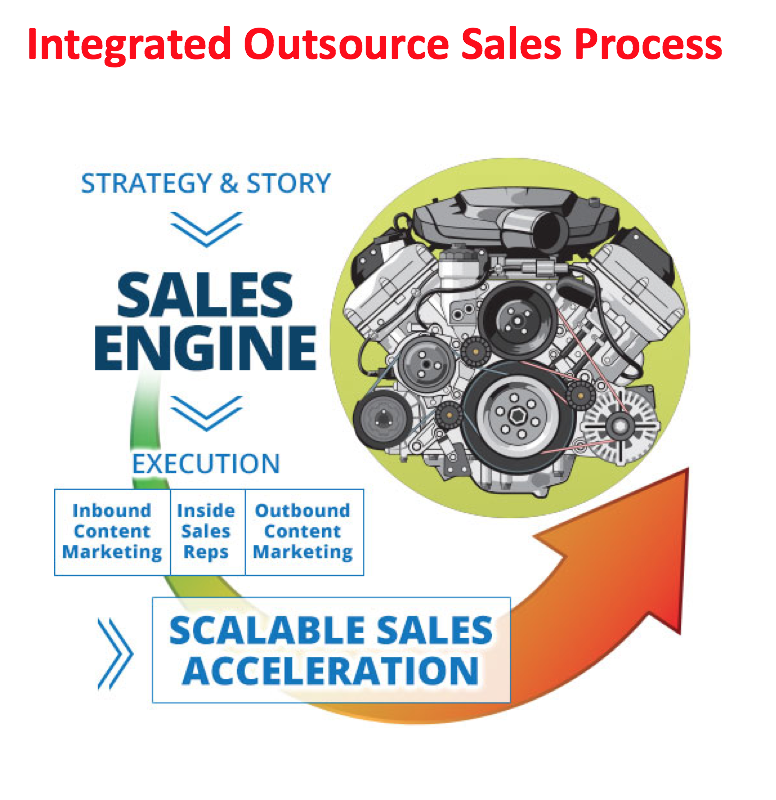by Glen Springer | May 26, 2017
There are multiple reasons to consider an outsource sales company for lead generation and lead qualification to help you grow your revenue and shape your company’s growth strategy.
For example, a tech start up that has a proven product may need to accelerate its sales efforts prior to a round. Or an established business may need to test a new market. Employing an outsource sales company will help you get to market faster – an experienced sales outsourcing and marketing firm enables the startup to hit the ground running with an experienced sales team, rather than wait six months or longer to recruit and train an internal team.
Another typical reason involves testing a new solution or a new process or strategy. An outsourcing team can take on the blocking and tackling of generating leads and sales opportunities for the new product. This allows your existing sales force to stay dialed in on the established product line. With an outsource sales team, you can fine-tune your process for the new solution, document the process and lay the groundwork and infrastructure for a full-scale roll out with your existing team.
Sales outsourcing can also immediately improve a company’s targeting capacity, cold-calling efforts, email marketing tactics and inbound lead generation approach. All this will increase your capability and capacity to identify qualified leads and drive deals into the sales funnel.
So once you’ve decided hiring an outsource sales company makes sense for your company, here are 3 tips to help ensure you make an intelligent decision about which company is right for you:
Evaluate the outsource sales team’s credentials
When choosing any vendor, it’s important to understand who they have successfully worked with in the past. Most sales outsourcing companies will have case studies online and will also have testimonial videos available. And before you make the final purchase, they should be OK with you checking references from other clients. Ask questions about the specific sales and marketing gaps you would like them to cover.
Determine if there is a strategic fit
A solution only works if the vendor’s capabilities meets your organization’s needs. When you outsource sales this means different things to different companies. Ask direct questions about their areas of strength. Some focus primarily on lead generation. Some focus end-to-end sales services. Others, like Gabriel Sales, build modern sales and marketing operations that can be transitioned over to the company. It’s also important to consider a firm’s flexibility in adapting to changes in your sales needs. Will they transition teams or systems to you?
Examine processes expertise
Take a close look at what they are best equipped to service. Can they help you implement a process for pure transactional sales? Are they experts in solution sales where a senior rep needs to manage the close of the transaction? Examine how they report on sales metrics and if they can help you forecast. Will they share data or hide data? Do they help you grow your business? Or do they just put deals into your pipeline? Do they do both?
Assess the sales outsourcing and marketing technology stack
An outsource sales firm’s technology capabilities and expertise is now a key factor in the selection process. What type of demand-generation technologies does the firm employ? Are they using marketing automation? How will it make use of CRM and analytics to achieve your objectives? Are they tied to a set of platforms or are they flexible?
Other factors when selecting an outsource sales company
Other issues evaluate a potential an outsource sales company:
- Experience in your industry
- Experience with your decision maker type
- What type of feedback do they provide?
About Gabriel Sales Outsource Sales Solution
Gabriel Sales helps companies build modern sales and marketing operations to help small businesses and start ups build a consistent and sustained flow of qualified leads. To learn more, please visit our outsource sales approach page.
by Carol Springer | Aug 30, 2016
 Everyone that works in sales knows that finding great sales people is not easy. Gabriel Sales has 16 years’ experience in searching for the right B2B sales staff for our variety of clients. One observation that has become abundantly clear is that a charismatic, charming sales personas have amazing skills to aid in sales. They can engage in any conversation, they light up the room, and they just know what to say and when to say it, however keeping the CRM updated and staying on top of reporting may be a challenge. On the other hand, we have detail oriented folks – they know who to call when based on their sales system, they diligently have their notes up to date and pipeline clean and tidy. The rare find is the combo platter – the detail oriented, orderly, charismatic, charming sales professional. Whether we find the charmer or the organized, we learn how to support the team members’ strengths and weaknesses and adjust to make it work. Whichever personality type you can find, here are 4 key traits to look for that make great sales people.
Everyone that works in sales knows that finding great sales people is not easy. Gabriel Sales has 16 years’ experience in searching for the right B2B sales staff for our variety of clients. One observation that has become abundantly clear is that a charismatic, charming sales personas have amazing skills to aid in sales. They can engage in any conversation, they light up the room, and they just know what to say and when to say it, however keeping the CRM updated and staying on top of reporting may be a challenge. On the other hand, we have detail oriented folks – they know who to call when based on their sales system, they diligently have their notes up to date and pipeline clean and tidy. The rare find is the combo platter – the detail oriented, orderly, charismatic, charming sales professional. Whether we find the charmer or the organized, we learn how to support the team members’ strengths and weaknesses and adjust to make it work. Whichever personality type you can find, here are 4 key traits to look for that make great sales people.
Leadership
This person is strong-willed and does not let a loss affect their performance. This person will go into each day driven to exceed expectations, and take the criticism necessary to improve their performance. Nothing is taken personally because they are mature enough to understand it is to their benefit. This person comes up with new ideas and tactics and is not afraid to think outside the box. This person inspires others to take the extra step as well. Leadership is the first important quality of great sales people.
Drive
This person is willing to do anything to win. Typically we find that ex-high school/college competitive athletes are a great fit because they are competitive and know what it takes to win: hard work. Competition with co-workers keeps this person going, as well as their constant desire for self-improvement.
Management
There are leaders and there are managers. By manager, I am referring to that detailed person – the person who keeps on schedule, sets goals and meets them; the person that tracks his progress for anyone to pick up if he gets hit by a bus (of course that will never happen). This trait is critical to the person who wants to move up and eventually be the Director or VP of Sales as they understand organization and accountability- critical when reporting to execs and investors. Many salespeople do not want to move to the next level because of that extra responsibility required. I think that is actually a good thing – as we cannot have too many cooks in the kitchen, but having basic management skills is a quality I always look for in great sales people.
X-Factor
We all know someone who changes the energy of a room when they walk in. It is a rare trait, and often this personality trait is common in top sales performers. In an inside sales environment, this person will comfortably go off script and connect with customers on a personal level. As mentioned above, they just know what to say and when and make people feel good. While this is a tremendous trait to have, it cannot be faked. So don’t try to be that person if you are not; if you are seen as someone who is being artificial the sale can quickly evaporate.
If you are hiring, good luck! If you want to pass on hiring a sales person and leave it to us, read this article on sales outsourcing to see if it would be a good fit or just contact us here.
by gabriel_sales | Jul 15, 2014
 It seems that B2B sales and marketing today is dominated by a whole bunch of acronyms that didn’t exist twenty years ago—CRM, SEO, MA, SEM, MLM, PPC, SMM—the list goes on.
It seems that B2B sales and marketing today is dominated by a whole bunch of acronyms that didn’t exist twenty years ago—CRM, SEO, MA, SEM, MLM, PPC, SMM—the list goes on.
As these acronyms suggest, the world we now live in is a digital one. In order to succeed and thrive in it today, companies need to not only be sales and marketing experts, but digital experts as well.
For many companies, entering the digital game has been somewhat of a struggle:
Struggle to implement marketing automation
In a 2014 report published by Regalix on the State of Marketing Automation in 2014, it was found that two of the top obstacles to implementing marketing automation were lack of expertise to use the data and intelligence offered by the tool (55%) and complexity of marketing automation software (34%). Additionally, the report found that it took 64% at least six months to see results from their marketing automation implementations.
Struggle to engage customers via content marketing
A July 2014 report from the Online Marketing Institute found that while over half of B2B marketers claim their content marketing efforts are ‘very mature’ (51%), most are finding it difficult to develop content that engages customers (87%). The report suggests that the reason for this disconnect may be in B2B marketer’s focusing too much on closing the deal and not enough on creating compelling content for the entire lifecycle of the B2B buyer.
Struggle to prove marketing’s business value
The same report from Online Marketing Institute found that B2B companies are also having trouble tying their content marketing efforts back to real business value. 85% admitted that their content activity is only somewhat effective (or less) at delivering business value in terms of generating revenue, retaining customers, or winning customers’ long-term loyalty. Additionally, “when asked to look back at the past 12 months and rate the effectiveness of content marketing efforts, only 14% of those surveyed gave their content practices high marks for delivering value back to the business.”
Given these findings, it is no surprise that many B2B companies out there are looking for solutions to improve technology use, create more engaging content and prove the value of their efforts. One solution many B2B companies are finding success with is B2B sales and marketing outsourcing, and our next blog discusses three of outsourcing’s main advantages.
Continue Reading – 3 Ways an Outsourced B2B Sales Team Can Help Your Marketing Efforts
by Glen Springer | Jun 5, 2014
 In the first blog of this two part series, we learned that aiming to impress is not the most effective approach. In part #2 we will talk about aiming to empower.
In the first blog of this two part series, we learned that aiming to impress is not the most effective approach. In part #2 we will talk about aiming to empower.
The reason your prospect has shown up for your meeting is not to be impressed; it is to be empowered to solve their problem. Unfortunately, this is not how most salespeople sell. Most end up product dumping, talking way too much and not spending enough time probing, discovering and selling based on the customers responses and needs.
Features and benefits should be a part of your presentation, but they need to be tied to the idea of solving a specific problem raised by your prospect. Otherwise, you may spend a significant amount of time on irrelevant topics and features. You may even hit the right feature and benefit, but without knowing how it relates back to you prospect, you may totally miss why it matters to them.
The reasons you think your product is cool may not even register at all with your prospect and vice versa.
When buying a car, you aren’t sold until you’ve driven the car. Most people decide to purchase a car during the test drive because they are taking actions aimed at solving their own problems and envisioning themselves behind the wheel.
In your B2B sales meetings, giving your prospect the keys and the power to solve their problem is equivalent to:
- Allowing him/her to share the problem
- Encouraging dialogue
- Asking open-ended questions
- Relating the benefits back to his/her pain
- Allowing your solution to show how he/she can specifically ease that pain
Just let them be sold on their solved problems. Stop Talking. Ask a question. Listen. Tie everything back to the reason they showed up in the first place. If they haven’t mentioned interest in a particular feature, rethink whether it’s even worth mentioning. Wow them by giving them solutions—not another sales presentation.
By attempting to empower your prospects rather than impress them during your sales meetings, the sale becomes significantly easier and less stressful for everyone involved.
Learn more in this blog called The #1 Mistake Salesmen Make. You can learn more about the services we offer as a B2B sales outsourcing company here. Feel free to contact us with any questions.
by Glen Springer | Jun 4, 2014
 When presenting your product or solution, it is often the approach to attempt to impress your prospect with every feature and benefit, rave about personal accomplishments and achievements or your software’s bells and whistles.
When presenting your product or solution, it is often the approach to attempt to impress your prospect with every feature and benefit, rave about personal accomplishments and achievements or your software’s bells and whistles.
From our experience as a B2B sales outsourcing company, we have seen that this is not the most effective approach to closing deals. What is often missed and lost is that your prospect set aside time, has most likely read and digested some of your content and has now actually shown up to your meeting. A great deal of the battle has already been won.
This is now the time that your prospect is willing to open up, if you let them (most don’t). Trying to get someone to open up on a cold call is the total opposite: they don’t know who you are, why you called, what the call is about—and you most likely interrupted their day.
But, if you have your prospect in a sales meeting, you are past that point. Take advantage of the fact that you have the prospect all to yourself with little to no distractions. Don’t feature dump or sell on every benefit; if that is all your prospect wants, they can usually get this information on their own.
Your product or solution will also most likely be vetted by a technical person, so save the technical selling for him; he likes it. Business buyers want problems solved, and ROI helps them see it. You will get the next step if you’re a fit.
To get your prospects talking in a sales meeting, you don’t need any secret sales questions. Just ask them to recap why they agreed to meet and explain their situation and what they might be looking for. In doing this, they will tell you their pain that is why they are talking to you—not because you are such a great salesperson, or your product is wicked cool. Despite what we think, people really don’t want to talk to us (sales).
People only want to talk to sales when they think you can help solve a problem. That is where the focus needs to be, solving the prospect’s problem, not yours (more sales).
It transfers through the phone when you are self-serving. When the majority of what you do is talking, you lose. When you are listening and taking notes the majority of time, you’re winning.
Continue reading.
by gabriel_sales | May 16, 2014
 This is part 2 of a blog series on the ways B2B content marketing programs can fail. Click here for part one.
This is part 2 of a blog series on the ways B2B content marketing programs can fail. Click here for part one.
3. Unclear roles/responsibilities
Even if you have a strategy and content production processes in place, if no one knows what they are supposed to do, you content marketing program will fail. People cannot be expected to succeed if they are unclear on what their individual roles and responsibilities are.
For each and every step in content creation, editing, approval, publishing, sharing, etc., clear responsibility should be assigned. Even if certain steps seem insignificant or intuitive, assign and document responsibility. As business scales and content production increases, you will be extremely thankful you took the time to do this.
4. Poor use of technology
Today, content marketing is inherently bound to digital technology. This means that your ability to leverage digital marketing technologies will have a direct impact on the effectiveness of your content marketing programs. Not all marketing technologies are appropriate for all companies, so it is important to do your research as to which will be most effective for achieving your specific goals.
For B2B companies, leveraging a Customer Relationship Management (CRM) program as well as a marketing automation solution can dramatically increase the effectiveness of your content marketing efforts. These programs allow you to keep track of all of your prospects and track their individual engagement with your content to gauge interest and start building a digital relationship. Learn more about how B2B companies leverage marketing automation here.
5. Lack of consistent flow
As we’ve written about previously, marketers today are expected to act like publishers. This means a quarterly newsletter is no longer enough. Again, the right volume and flow will vary from business to business, but generally speaking, you need to make sure you have a consistent and steady flow of content coming out all year.
Writing weekly blog posts is a great way to establish consistency with your readers. It also gives early-stage prospects (who aren’t yet ready to buy) a way to get to know your company without feeling intimidated or threatened by aggressive sales messages. If you have the bandwidth, putting out a quarterly newsletter or series of videos is a great way to get traction from some of those prospects who haven’t engaged in a while.
For more tips on successful B2B content marketing, read 3 Tips for More Effective B2B Content Marketing. Feel free to contact us with any questions.
 Everyone that works in sales knows that finding great sales people is not easy. Gabriel Sales has 16 years’ experience in searching for the right B2B sales staff for our variety of clients. One observation that has become abundantly clear is that a charismatic, charming sales personas have amazing skills to aid in sales. They can engage in any conversation, they light up the room, and they just know what to say and when to say it, however keeping the CRM updated and staying on top of reporting may be a challenge. On the other hand, we have detail oriented folks – they know who to call when based on their sales system, they diligently have their notes up to date and pipeline clean and tidy. The rare find is the combo platter – the detail oriented, orderly, charismatic, charming sales professional. Whether we find the charmer or the organized, we learn how to support the team members’ strengths and weaknesses and adjust to make it work. Whichever personality type you can find, here are 4 key traits to look for that make great sales people.
Everyone that works in sales knows that finding great sales people is not easy. Gabriel Sales has 16 years’ experience in searching for the right B2B sales staff for our variety of clients. One observation that has become abundantly clear is that a charismatic, charming sales personas have amazing skills to aid in sales. They can engage in any conversation, they light up the room, and they just know what to say and when to say it, however keeping the CRM updated and staying on top of reporting may be a challenge. On the other hand, we have detail oriented folks – they know who to call when based on their sales system, they diligently have their notes up to date and pipeline clean and tidy. The rare find is the combo platter – the detail oriented, orderly, charismatic, charming sales professional. Whether we find the charmer or the organized, we learn how to support the team members’ strengths and weaknesses and adjust to make it work. Whichever personality type you can find, here are 4 key traits to look for that make great sales people.





